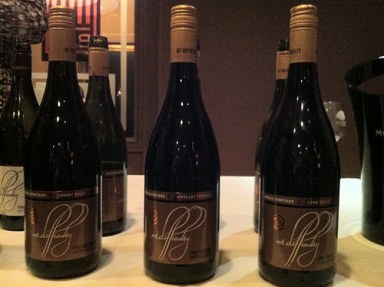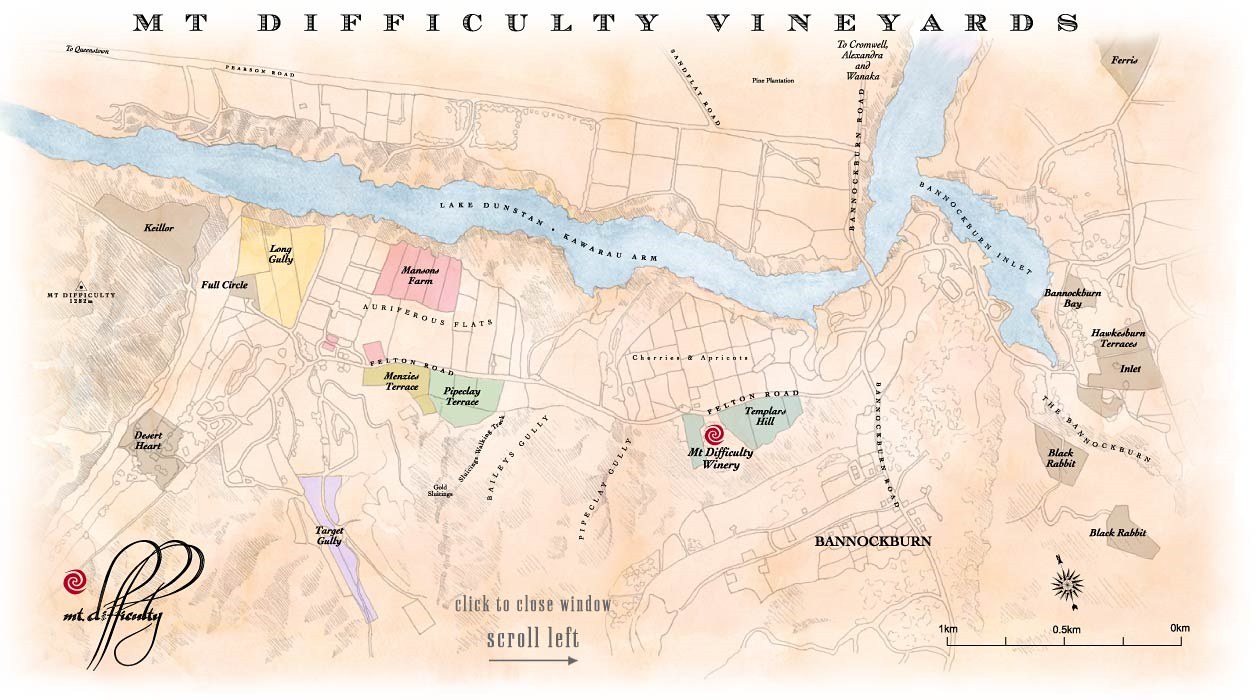Separation of Pinots: New Zealand & More Mt. Difficulty
Post by Chuck Hayward | August 25th, 2011
Back when New Zealand pinot noir first entered the US market, our collective knowledge of these wines was infinitesimal. The country's first serious attempts at producing pinot noir production had begun only a decade earlier, so the 1995/96 vintages that made the initial splash had few reference points. At that time, no one could say how Marlborough differed from Martinborough. Rather, the question was how the pinots of New Zealand compared to those from Burgundy, California and Oregon.
As the pinot noir industry matured, it became easier to understand the unique attributes and qualities among New Zealand's growing regions, which was important so that customers could purchase the style of wine they prefer. Almost right away, however, it became apparent that not all wines from Central Otago were the same and that Marlborough pinots from the valley floor were markedly different compared to those from the southern hills. The quest to learn about a New Zealand wine appellation's subregionality became important rather quickly.
In Central Otago, where subregional differences first became apparent to me, there are 6-7 loosely defined districts whose pinot noirs offer their own unique interpretations of the grape. Martinborough, Marlborough and Waipara also see differing pinot styles depending on their site, while Hawkes Bay Bordeaux-style red blends show incredible diversity that can be attributed to subregional differences.

- Mt. Difficulty Single Site Pinots from 2009
As growers and winemakers become even more familiar with their vineyards, they are now able to discern even finer differences in their fruit. Different blocks within their vineyards are being singled out and bottled separately—giving pinot geeks a unique view of their vineyards. It all started with Felton Road when they issued their rare "Block 3" and "Block 5" pinots over a decade ago. Since then, wineries like Rippon, Mountford and Escarpment began making pinots that reflect this passion for subtle nuances in their wines. These new, low quantity wines represent the latest trend in New Zealand pinot noir production.

- Very little can "top" a bottle of Mt. Difficulty
Over the past decade, Mt. Difficulty has taken this drilled-down approach to the block level producing small quantities of pinot noir from three different sites. In each vintage, they look at wines from their top three blocks to determine if they should be bottled separately, at the same time, not cause their classic release to suffer from the separation. The 2009 single-vineyard wines represent the first time that the winery has released the Long Gully, Pipeclay Terrace and Target Gully pinots in one year, attesting to the high quality of the vintage. Each of these rare, single vineyard pinots is produced in small amounts of 300 or so cases with only 10-15 sixpacks allocated to the US market.
Mt. Difficulty's vineyards are located in the Bannockburn subregion of Central Otago, an area renowned for high-quality, fully flavored pinots. Home to wineries like Felton Road, Carrick and Akarua, vineyards here have north-northwest exposures that allow fruit to ripen perfectly. With their first wines released in 1998, the winery quickly found out that certain blocks created some top pinot noirs so they developed their Single Vineyard Wine Series in 2002. The recent Mt. Difficulty tasting held at the Mandarin Oriental Hotel in San Francisco allowed us to be the first in the States to try these wines side by side and afforded many the chance to taste the different blocks comparatively for the first time.

- Click this map for a larger view on Mt. Difficulty's website
Long Gully Vineyard
This vineyard has historically produced the most feminine and elegant bottling of the Single Vineyard Series. Located on a small flat plain overlooking Lake Dunstan, the slightly richer soils allow for plush yet delicate fruit textures. But given time, the wines gain richness and weight to become compelling examples as compared to their neighbors. Winemaker Matt Dicey has seen the fruit from this 20-year-old vineyard evolve to reveal more savory textures.
The 2009 shows deep colors that are just opaque at the core. With a hint of sweet fruit and chocolate on the nose, some classic Otago dusty spices lay underneath. There is some subtle structure here with a core of soft fruit at the palate that maintains purity and density but is tightened up by firm tannins. More delicate compared with the other bottlings, this wine shows a great balance of intensity and grace.
I also had a chance to taste the 2005, which has matured very slowly due to the cool weather conditions. Concentrated and densely packed aromas of spicy blackberry and dark cherry on nose. Overall, the impression is of a true vin de garde, backward and reserved, a bit blocky and lacking some finesse at this point, with a firm finish to complete the experience. Just waking from its slumber in the last 12-18 months, according to Dicey, and given how well the estate pinots have aged, I could see this lasting another ten years.
Target Gully Vineyard
The Target Gully Vineyard occupies a space, both literally and stylistically, in the middle of the Mt. Difficulty trio. It is also the most mysterious cuvee, having only been made twice. This 18-year-old plot lies adjacent to Block 9 and 11 of Felton Road's vines, tucked behind a small rise and not as exposed as the other Mt. Difficulty sites. In my experience, it is a more compact expression of the Mt. Difficulty style with less expressive fruit and a compact palate profile.
The current release is barely opaque in color. This is a masculine, powerful wine that maintains a beautiful balance of fruit and structure. A trait of the vintage, the tannins are a bit pronounced, with a great concentration of soft fruits at the backpalate but not the lusher textures found in the Long Gully.
The first release was the 2003, and this wine was a bit backward and unevolved with dark fruits and crunchy textures on the backpalate. Displaying a robust facet here, the palate shows an emphasis on the wine's firm and slightly blocky nature. This somewhat square wine has lovely subtle flavors of dusty, sour cherries as the wine ends up with a firm finish and spicy tannins.
Pipeclay Terrace Vineyard
This has generally been the most powerful of the three wines with intense fruit flavors lying atop structural notes that indicate good aging potential. Offering a richer counterpoint to the more understated Long Gully cuvee, the Pipeclay bottling has become the most popular of the three wines. Winemaker Matt Dicey has noticed a spicy component emerging as the vines have aged.
The 2009 bottling is more translucent in color than the other bottlings. The nose is a bit more subtle but still possesses concentrated, spicy fruit. The fruit on the palate is more compressed in shape with classic dark cherry flavors. Dicey observed that their 2009s were tannic, which can be seen here with firm tannins on the finish.
A 2004 example is very opaque, almost darker than all the others being shown today. The closed bouquet shows dark cherry coughdrop aromas with subtle chocolate notes underneath. Bottle age has softened the fruit textures with flavors of berries and dark fruit lingering, along with subtle tannins. Very round at the back, the profile is compact and the finish is tight. Another 6-8 years of aging will be easy for this wine.